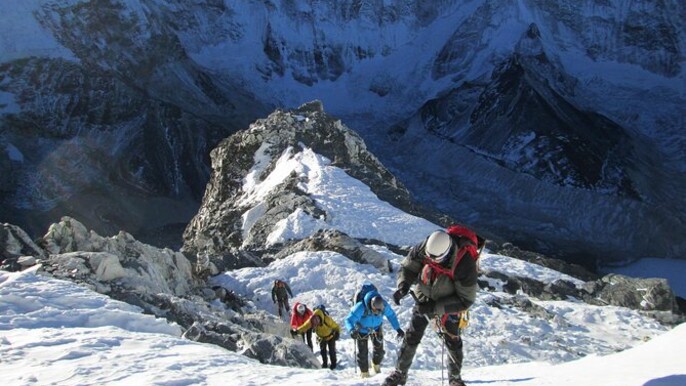18-Day Himalayan Climb with Everest Base Camp Acclimatization

Description
Island Peak (6,189m), locally known as Imja Tse, offers one of the best introductions to Himalayan climbing. This 18-day expedition by Osho World Adventure Pvt. Ltd. combines the classic Everest Base Camp trek with a fully guided ascent of Island Peak. Perfect for adventurous trekkers with good fitness and basic climbing interest, it’s a once-in-a-lifetime journey through Sherpa villages, glaciers, high passes, and finally to the summit—rewarded by unmatched views of Lhotse, Ama Dablam, and Makalu.
No prior mountaineering experience? No problem. Our expert guides provide all the training and support you need.
Included
- 16x Breakfast
- 13x Dinner
- 12x Lunch
- Accommodation included: 16 nights
- Climbing peak permit and one climbing guide (Sherpa)
- A guide & porter during the trek
- All inclusive bills and expenses for guide and porter
- National Park entrance permit
- All meals during the trek and climbing
- Accommodation in lodge during the trek, basic camping arrangement during climbing.
- Staff insurance
- Flight for Kathmandu - Lukla - Kathmandu for member and for crew
- All airport pick up and drop
- Emergency evacuation arrangement if in case, pay by your insurance
- A Trekking/climbing route map
- Local transportation
- Entry/Admission - Phakding
- Entry/Admission - Sagarmatha National Park Museum
- Entry/Admission - Namche Bazaar
- Entry/Admission - Tengboche Gompa
- Entry/Admission - Dingboche Stupa
- Entry/Admission - Dingboche View Point
- Entry/Admission - Dingboche Village
- Entry/Admission - Tengboche Monastery
- Entry/Admission - Khumjung Gompa
- Entry/Admission - Lukla Bazaar
- Entry/Admission - Thamel
Excluded
- Personal clothing.
- Personal accident insurance, emergency evacuation cost, oxygen, medical box.
- Alcoholic beverage, laundry and tips.
- Hotel accommodation and sightseeing tour in Kathmandu (available as per your choice)
- Climbing equipment
- Entry/Admission - Kathmandu Durbar Square
- Entry/Admission - Swayambhunath Stupa
- Entry/Admission - Pashupatinath Temple
- Entry/Admission - Boudhanath Stupa
Know before you go
Porter-supported trek
Two clients share one porter. We will supply you with a trek duffel bag where you keep your heavy items and this bag is carried by the porter. You will need to bring your own daypack to be carried by you. In the daypack, you can put money, important documents, water bottle/bladder, camera, toiletries, sunscreen, notebook, etc.
Baggage Weight Limitation
The weight limit for Kathmandu-Lukla-Kathmandu flights is 15 kg or 33 pounds. This is combining both the duffel bag and the daypack. If you exceed this limit, you will have to pay an additional fee. When this happens, sometimes the airline sends your bag in later flights and this can be very problematic for many reasons. You can leave your non-trekking stuff at the locker facility in the Kathmandu hotel.
Climbing gear
The Climbing equipments are more expensive to buy. So, please let us know if you want to rent the equipments at the additional cost of USD 250 per person. The Following equipments are essential for climbing Island peak.
- 1 pair plastic shell mountaineering boots with high altitude liners
- 1 pair of crampons (steel, no aluminum).
- 1 Alpine climbing harness.
- 1 Mountaineering an axe with leash (sized properly for your height)
- 1 Ascender (right or left handed as appropriate)
- 1 Belay device (Black Diamond ATC or ATC Guide are good options)
- 2 D-Shaped locking carabiners
- 2 Non-locking carabiners
- 1 Pair expedition style gaiters (ensure fit over your boots)
- Neck gaiter
- Ski goggles (optional)
- Climbing helmet (optional)
General
- 4 seasons Sleeping bag (Optional/we can provide one if you need it but is to be returned after the trek)
- Duffel or Rucksack bag or suitcase (We will provide one complimentary ACE duffel bag for you to keep.)
- Daypack
- Down Jacket (Optional/we can provide if you need one but is to be returned after the trek)
Upper Body - Head / Ears / Eyes
- Shade hat or baseball cap – some people drape a bandana down the back of their head and then put a baseball cap on to hold it is place. This can be a flexible alternative while keeping the sun off your ears and neck.
- Warm wool or synthetic hat that cover your ears.
- Balaclava – lightweight, thinner variety.
- Glacier glasses-100% UV protection with side shields and a hard-sided storage case (i.e. Julbo or Cebe). This is to protect your eyes from the stronger rays of the sun due to the thinner atmosphere which can cause a painful condition known as snow blindness. Regular sunglasses are not sufficient. If you wear prescription glasses, speak to your doctor about prescription glacier glasses, perhaps with transitional lenses.
- Headlamp – Black Diamond and Petzl both make several good ones. Make sure to bring extra batteries and that they are lithium batteries so that they will last in the colder temperatures. These are indispensable for getting around at night, reading, etc. so, don’t go cheap here.
- Some people like ear-muffs; These are optional; a good hat, balaclava, and hooded jacket should really be sufficient, but this is a personal choice for some people (optional).
- A neck warmer is another piece of gear for extra warmth if you feel you will need it (optional).
Hand
- 1 pair liner gloves, thin wool or synthetic, useful alone on mild days or as a layer inside other gloves/mitts for additional warmth.
- 1 pair warm gloves (heavier fleece or wool).
- 1 pair shell gloves or mitts; Gore-Tex is preferred for keeping hands dry.
- Instant hand warmers are always nice in a pinch, but really shouldn’t be necessary on the trek. Bringing appropriate hand protection as recommended above, should be sufficient (optional).
Core Body
- T-shirts (2).
- Light and expedition weight thermal tops.
- Fleece jacket or pullover.
- Fleece Wind-Stopper jacket (optional).
- Waterproof (preferably breathable fabric) shell jacket.
- 2 women sports bras, Synthetic, no cotton!
Lower Body – Legs
- 2 pairs nylon hiking shorts – Quick drying type, not cotton!
- Underwear, stay away from cotton (4).
- 2 pairs lightweight long underwear – Capilene or other synthetic.
- 1 pair soft shell pants – synthetic, full zip from top and bottom preferable.
- 2 pairs trekking pants, preferably that zip on/off at the knees so they double as shorts.
- 1 pair hard shell pants. Waterproof / breathable, Gore-Tex or equivalent is best. Should zip from the top and bottom – this makes it easier to put on over boots without getting undressed should the weather change once you are underway for the day.
- 1 pair cotton pants (loose jeans/khakis).
- All clothing should be kept dry using waterproof stuff sacks or large puncture resistant plastic bags.
Feet
- 4 pairs of liner socks, synthetic or Capilene.
- 3 pairs heavy weight socks to be worn over liner socks.
- 1 pair light weight socks, a good option for the lower / warmer parts of the trail.
- 1 pair light to medium weight waterproof hiking/trekking boots. Ensure a good fit with layered socks and you have worn them before to get used to it (otherwise you will get lots of blister).
- 1 pair light trekking shoes or sneakers. Good for around the camp/lodges and in Kathmandu.
- 1 pair hiking gaiters, good for keeping dust and rocks out of your shoes/boots as well as keep your feet dry as necessary (Optional).
- 1 pair sandals (Optional).
Medicines and First Aid Kits
(Please note our guide will also carry the first aid kit bag during the trek. However, we still recommend you to bring your personal first aid kit as well)
- Extra Strength Excedrin for altitude related headaches.
- Ibuprofen for general aches and pains.
- Immodium or Pepto Bismol capsules for upset stomach or diarrhea.
- Diamox (commonly prescribed as Acetazolamide) 125 or 250mg tablets for altitude sickness. Please discuss with us before starting to take this medicine.
- 1 small personal sized first-aid kit with blister treatments such as mole skin, band-aids, some waterproof tape, anti-infection ointments, etc. Your guides will have more extensive medical gear, but you should have the basics for general use.
Miscellaneous
- Passport and extra passport photos (4 copies).
- Airline ticket (Please make a copy and leave on at our office in Kathmandu just in case if you need to change the date of your).
- Durable wallet/pouch for travel documents, money & passport.
- Lip balm. At least SPF 20, 2 sticks. A string taped to the stick is helpful, to hang around your neck and some are now being sold with a cord already attached. Handy as it avoids you from having to stop and look for it.
- Sunscreen. SPF 40 is recommended and should be relatively new since it loses its’ effectiveness over time.
- Pocket knife or small Swiss Army type.
- Water purification Iodine tablets or Polar-pure crystals.
- Toiletry kit. Be sure to include toilet paper stored in a plastic bag, hand wipes, and liquid hand sanitizer, towel, soap, etc.
- 2 bandanas.









